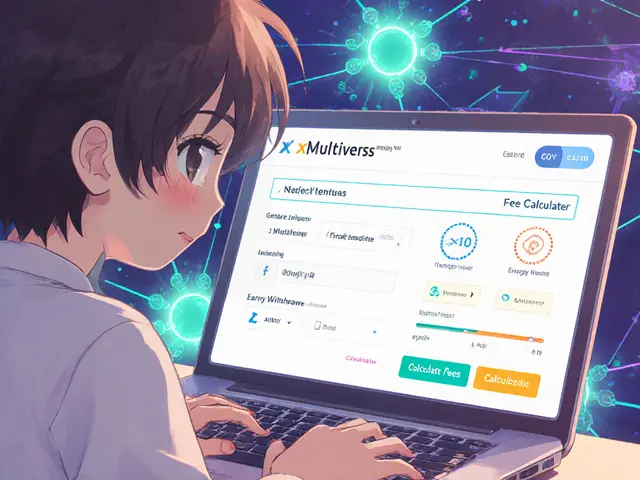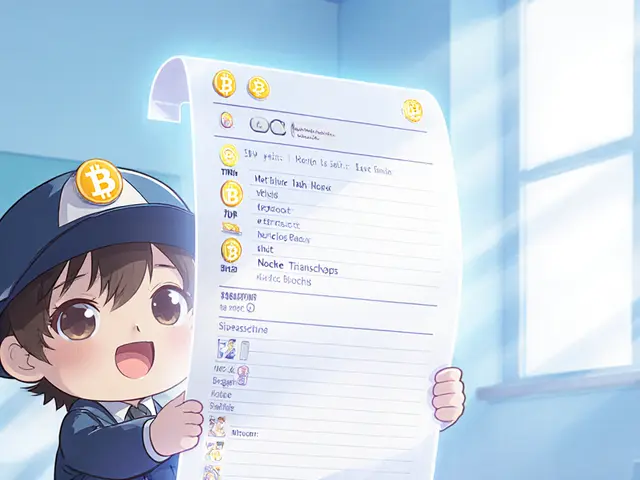NEO vs Ethereum Comparison Tool
NEO
China's first open-source blockchain platform
Dual-token system: NEO (ownership) + GAS (fuel)
Ethereum
The original smart contract platform
Single-token system: ETH
| Feature | NEO | Ethereum |
|---|---|---|
| Consensus Mechanism | Delegated Byzantine Fault Tolerance (DBFT) | Proof-of-Stake (Ethereum 2.0) |
| Transactions Per Second | ~3,000 TPS | ~30-100 TPS (post-merge) |
| Token Model | Dual-token (NEO + GAS) | Single token (ETH) |
| Supported Languages | Python, C#, Java, Go, Kotlin | Solidity, Vyper |
| Governance | Neo Council (delegated nodes) | Community-driven via EIP process |
| Major Partners | Microsoft, Chinese enterprises | Consensys, DeFi projects |
- NEO Supply Limit 100 million
- GAS Release Period 22 years
- NEO Launch Year 2014 (Antshares)
- Founder(s) Da Hongfei & Erik Zhang
- NeoVM Support Python, C#, Java, Go, Kotlin
When you hear people mention NEO is China’s first open‑source blockchain platform that aims to build a "smart economy" by automating digital assets with smart contracts, you might wonder if it’s just another Bitcoin copy. In reality, NEO crypto tries to blend the flexibility of Ethereum with the speed of traditional databases, all while keeping a strong focus on regulatory‑friendly features.
Quick Takeaways
- NEO launched as Antshares in 2014 and rebranded in 2017.
- It uses a dual‑token system: NEO (ownership) and GAS (network fuel).
- Consensus is powered by Delegated Byzantine Fault Tolerance (DBFT), enabling thousands of transactions per second.
- The platform runs on NeoVM, a virtual machine that supports mainstream languages like Python, C#, Java, Go and Kotlin.
- Microsoft has been a strategic partner since the 2017 rebrand, lending credibility to the ecosystem.
Where NEO Came From
Co‑founders Da Hongfei and Erik Zhang started the project as Antshares in 2014, aiming to bring blockchain tech to Chinese enterprises. By 2017 they renamed the network to NEO and introduced a fresh vision: a "smart economy" where assets, identities, and contracts live on a shared ledger. Erik Zhang also invented the Delegated Byzantine Fault Tolerance (DBFT) consensus, making NEO the first blockchain to use that algorithm.
How the Dual‑Token System Works
The NEO token itself is indivisible - you can’t own 0.5 NEO - and represents a stake in the network’s governance. Holding NEO automatically generates GAS, which you need to pay transaction fees and run smart contracts. Think of NEO as the share you own in a company, while GAS is the electricity that powers the office. At launch, 100million NEO were pre‑mined, and a total of 100million GAS will be released over about 22 years through a decay algorithm.
Consensus and Virtual Machine
NEO’s DBFT consensus works by selecting a limited set of trusted nodes - the Neo Council - to validate blocks. This structure avoids the energy waste of proof‑of‑work and enables roughly 3,000 transactions per second, a figure that puts it ahead of many early‑stage blockchains.
Once a block is agreed upon, the NeoVM executes the code. NeoVM is language‑agnostic, meaning developers can write smart contracts in familiar languages like Python, C#, Java, Go or Kotlin. This lowers the entry barrier and speeds up DApp development, something traditional Ethereum developers often complain about.

NEO vs. Ethereum: A Side‑by‑Side Look
| Feature | NEO | Ethereum |
|---|---|---|
| Consensus | Delegated Byzantine Fault Tolerance (DBFT) | Proof‑of‑Stake (Ethereum 2.0) |
| Transactions per second | ~3,000 TPS | ~30‑100 TPS (post‑merge) |
| Token model | Dual‑token (NEO + GAS) | Single token (ETH) |
| Programming languages | Python, C#, Java, Go, Kotlin | Solidity, Vyper |
| Governance | Neo Council (delegated nodes) | Community‑driven via EIP process |
| Major partners | Microsoft, Chinese enterprises | Consensys, numerous DeFi projects |
In plain English, NEO offers higher throughput and lets you code in everyday languages, while Ethereum enjoys a larger ecosystem and more DeFi projects. Your choice often boils down to whether you value speed and ease of development (NEO) or ecosystem depth (Ethereum).
Is NEO a Good Investment Right Now?
NEO peaked at $196 in 2018, then fell to the low‑teens range. As of October 2025, price forecasts vary widely: some analysts see it hovering around $11‑$12, while optimistic models predict a climb to $36 or even $93 by mid‑2025. The disparity stems from market volatility, regulatory shifts in China, and the overall crypto sentiment.
If you’re looking for a high‑risk, high‑reward play, NEO’s limited supply (100million) and its strong corporate backing (Microsoft) could fuel a rebound, especially if Chinese regulators soften. On the flip side, the dual‑token complexity and concentration of NEO holdings (top 10 addresses control >50%) add risk for retail investors.
Getting Started: Buying, Storing, and Staking NEO
Want to own NEO? Most major exchanges list it, so you can buy with fiat or other crypto. After purchase, move the coins to a wallet that supports both NEO and GAS - the official Neo Wallet, O3Wallet, and hardware options like Ledger all work.
Staking is simple: once your NEO sits in a compatible wallet, the network automatically generates GAS for you. No need to lock up funds or run a node; just keep the wallet online and watch the GAS accumulate.
Potential Pitfalls and Things to Watch
First, the governance model means a handful of validators hold a lot of power. If the Neo Council changes policy, it could affect token economics.
Second, the two‑token system can confuse newcomers; forgetting that GAS, not NEO, pays transaction fees is a common mistake.
Finally, regulatory risk stays high. While Microsoft’s involvement signals institutional confidence, Chinese regulations on crypto can still impact development and market access.
Frequently Asked Questions
What is the difference between NEO and GAS?
NEO represents ownership and voting rights on the platform, while GAS is the utility token used to pay for transactions and to run smart contracts. Holding NEO automatically generates GAS over time.
Can I earn GAS without running a node?
Yes. Simply keep NEO in a supported wallet and the network will credit you GAS periodically. No staking contracts or lock‑ups are required.
Is NEO compatible with popular programming languages?
Absolutely. NeoVM lets developers write smart contracts in Python, C#, Java, Go, Kotlin and other mainstream languages, which lowers the learning curve compared to Solidity‑only platforms.
How does Delegated Byzantine Fault Tolerance improve speed?
DBFT relies on a pre‑selected group of trusted nodes (the Neo Council) to validate blocks, removing the need for energy‑intensive mining. This streamlined process enables thousands of transactions per second.
Where can I buy NEO safely?
Major exchanges such as Binance, Coinbase, and KuCoin list NEO. After buying, transfer the coins to a secure wallet that supports both NEO and GAS to retain full control.




Jeff Carson
December 6, 2024 AT 12:42NEO’s Delegated Byzantine Fault Tolerance really flips the script on the usual energy‑guzzling mining – it’s fast, low‑cost, and keeps the network cute and clean 😎. The dual‑token system can look confusing at first, but think of NEO as the equity stake and GAS as the electricity that powers every transaction. Because the Neo Council handles block validation, you’re looking at around 3,000 TPS, which blows most of the early‑stage chains out of the water. If you’re a dev who hates learning Solidity, the fact that you can code smart contracts in Python or C# is a massive confidence boost. And let’s not forget Microsoft’s backing – that’s a corporate vote of confidence you don’t see every day. All in all, if you value speed, mainstream language support, and a solid institutional partner, NEO deserves a spot on your watchlist.
Anne Zaya
December 14, 2024 AT 15:42Honestly, the NEO/GAS combo feels a lot like owning a share that pays you a dividend automatically – you just sit back and watch the GAS drip in while you hold NEO.
Emma Szabo
December 22, 2024 AT 18:43What’s really exciting about NeoVM is that it democratizes smart‑contract development. You can write in Python, C#, Java, Go, or Kotlin, which means you don’t have to choke on Solidity’s quirks just to get a DApp off the ground. This opens the door for a whole generation of developers who have been staring at crypto‑dev tutorials and thinking “nope, that’s not for me”. Plus, the dual‑token model gives you a built‑in incentive: the more NEO you hold, the more GAS you earn, which can be reinvested or used to pay for future contract executions. The whole ecosystem is geared toward a “smart economy” where assets, identities, and contracts live in harmony, and that’s a vision that feels much more inclusive than the early Bitcoin‑only mindset. 🌈🚀
Fiona Lam
December 30, 2024 AT 21:43Ethereum’s slow TPS and endless gas wars make it look like a dinosaur trying to run a marathon. NEO’s 3,000‑plus TPS makes Ethereum’s 30‑100 TPS look like child’s play, and the fact that you can code in everyday languages is a slap in the face to Solidity‑only purists. If you’re still betting on ETH to dominate, you’re basically betting on a snail when there’s a cheetah right next to it.
Susan Brindle Kerr
January 8, 2025 AT 00:44NEO is the phoenix rising from the ashes of Bitcoin, soaring above the crowd with blazing speed and glittering partnership with Microsoft – a true legend in the crypto saga.
Jared Carline
January 16, 2025 AT 03:44From a regulatory perspective, Neo’s architecture presents a noteworthy case study. The governance model, centered upon a delegated council, affords a degree of oversight that contrasts sharply with the anarchic disposition of certain proof‑of‑work networks. Moreover, the separation of ownership (NEO) from utility (GAS) introduces a bifurcated token economy that may satisfy both investors seeking equity‑like exposure and users requiring transaction fuel. While the dual‑token framework arguably complicates the tokenomics, it simultaneously provides an intrinsic incentive mechanism that merits scholarly examination.
raghavan veera
January 24, 2025 AT 06:45Think of NEO as a digital agora where assets, identities, and contracts mingle freely, each reinforcing the other in a symbiotic dance. The idea of a “smart economy” isn’t just hype; it’s an attempt to embed trustless automation into the very fabric of our daily exchanges. When the Neo Council validates blocks, it’s akin to a council of elders deciding the fate of a town – efficient, trusted, and less wasteful than every miner shouting for a piece of the pie.
Danielle Thompson
February 1, 2025 AT 09:45Storing NEO in a hardware wallet is the safest option 🔐.
Eric Levesque
February 9, 2025 AT 12:46GAS is the fuel you need to run contracts on Neo, so keep your NEO in a wallet that supports GAS generation.
alex demaisip
February 17, 2025 AT 15:46The tokenomics of Neo are underpinned by a fixed supply cap of 100 million NEO, coupled with a decaying release schedule for GAS over a 22‑year horizon. This deterministic emission model curtails inflationary pressures, thereby preserving value accrual for long‑term holders. Moreover, the orthogonal nature of the governance token (NEO) and the utility token (GAS) facilitates a clear demarcation between voting power and transactional capacity, mitigating the conflation often observed in monolithic token ecosystems.
Elmer Detres
February 25, 2025 AT 18:47💥 That deterministic model sounds cool, but without real‑world adoption the numbers mean jack‑shit. You need users, not just fancy math!
Tony Young
March 5, 2025 AT 21:47NEO’s hybrid approach really shines when you look at the ecosystem’s real‑world use cases. From supply‑chain tracking pilots in Chinese enterprises to digital identity projects backed by Microsoft, the platform is proving that sheer transaction speed translates into tangible business value. The fact that GAS is generated simply by holding NEO means participants are rewarded for their faith, creating a self‑sustaining loop that many other chains struggle to achieve. 🎭✨
Fiona Padrutt
March 14, 2025 AT 00:48Yeah, sure, hype aside, those pilots are still sandbox demos. Until you see massive DeFi liquidity on Neo like on Ethereum, the whole “real‑world value” claim is just marketing fluff.
Briana Holtsnider
March 22, 2025 AT 03:48While the enthusiasm for DeFi on Ethereum is undeniable, it also masks the severe scalability bottlenecks that have plagued the network for years. Neo’s architecture, by contrast, offers a pragmatic path forward that many overlook in the frenzy.
Corrie Moxon
March 30, 2025 AT 06:49If you keep an eye on the roadmap and the upcoming Neo3 upgrades, there’s a lot of potential for bridging the gap with other blockchains and expanding the developer community.
OLAOLUWAPO SANDA
April 7, 2025 AT 09:49Regulators in China are still tightening crypto rules, so betting big on Neo could bite you harder than you think.
Alex Yepes
April 15, 2025 AT 12:42Neo’s evolution from Antshares to its current incarnation illustrates a rare continuity in the volatile crypto sector.
The project’s decision to adopt Delegated Byzantine Fault Tolerance early on positioned it ahead of many contemporaries seeking consensus efficiency.
By limiting block validation to a vetted council, the network achieves low latency while preserving a degree of decentralization appropriate for enterprise use cases.
The dual‑token design, separating ownership (NEO) from utility (GAS), creates an internal incentive structure that aligns stakeholder interests with network health.
This mechanism mirrors dividend‑paying equities, offering passive income to long‑term holders without the need for complex staking contracts.
Moreover, NeoVM’s language‑agnostic nature lowers barriers to entry, attracting developers proficient in mainstream languages such as Python, C#, and Java.
The partnership with Microsoft not only provides cloud infrastructure support but also lends institutional credibility that few other platforms can claim.
In practice, several pilots in supply‑chain management and digital identity have demonstrated tangible throughput benefits, confirming the theoretical TPS advantage.
However, the concentration of NEO holdings among a handful of addresses raises centralization concerns that merit close monitoring.
Market adoption remains modest compared to Ethereum, and the ecosystem’s DeFi offerings are still in nascent stages.
Regulatory uncertainty, especially within China, adds an additional layer of risk that investors must weigh.
Despite these challenges, Neo’s roadmap includes cross‑chain interoperability upgrades that could unlock broader utility.
The upcoming Neo3 release promises enhanced governance models and improved developer tooling, which may drive community growth.
As the blockchain landscape matures, platforms that combine performance, language flexibility, and enterprise partnerships are well‑positioned to capture niche markets.
Consequently, Neo represents a compelling, albeit cautious, addition to a diversified crypto portfolio.